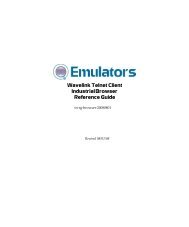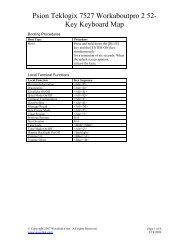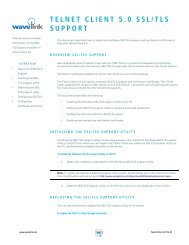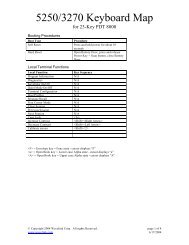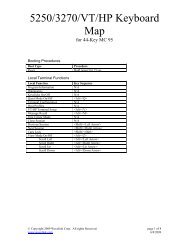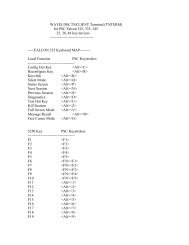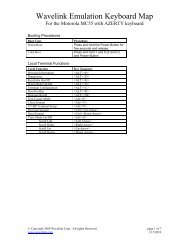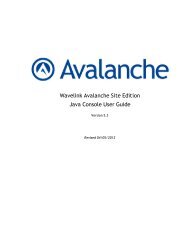Wavelink Avalanche Site Edition Java Console User Guide
Wavelink Avalanche Site Edition Java Console User Guide
Wavelink Avalanche Site Edition Java Console User Guide
Create successful ePaper yourself
Turn your PDF publications into a flip-book with our unique Google optimized e-Paper software.
Chapter 4: <strong>Avalanche</strong> <strong>Console</strong> 27<br />
Profiles Configuration<br />
The tasks in this region are optional and can be done in any order. These tasks<br />
include:<br />
• Create a Network Profile. For details, refer to Chapter 7: Managing Network<br />
Profiles on page 63.<br />
• Add Device Software. For details, refer to Chapter 10: Managing Software<br />
Profiles on page 101.<br />
• Create a Scan to Config Profile. For details, refer to Chapter 8: Managing<br />
Scan to Configure Profiles on page 76.<br />
Tools<br />
This section allows you to install an <strong>Avalanche</strong> Enabler onto a mobile device<br />
or check for <strong>Avalanche</strong> updates.<br />
Help and Support<br />
This region provides links to the <strong>Avalanche</strong> Help, <strong>Wavelink</strong> Support, and<br />
launches the Support Generator. For details about using the Support<br />
Generator, refer to Using the Support Generator on page 40.<br />
Profiles Tab<br />
From the Profiles tab you can manage your profiles. A profile allows you to<br />
apply the same set of configurations to multiple servers or devices. There are<br />
eight types of profiles in <strong>Avalanche</strong> MC:<br />
• Alert profile. An alert profile allows you to configure what events generate<br />
an alert and who is notified when an alert is generated. For information on<br />
alert profiles, see Chapter 13: Managing Alert Profiles on page 153.<br />
• Mobile Device Server profile. A Mobile Device Server profile allows you<br />
to configure administrative, security, and connection settings for your<br />
Mobile Device Servers. For information on Mobile Device Server profiles,<br />
see Chapter 9: Managing the Mobile Device Server on page 86.<br />
• Mobile device profile. A mobile device profile allows you to change<br />
settings on your mobile devices, as well as add, change, and remove<br />
custom properties and registry keys. For information on mobile device<br />
profiles, see Mobile Device Profiles on page 136.




